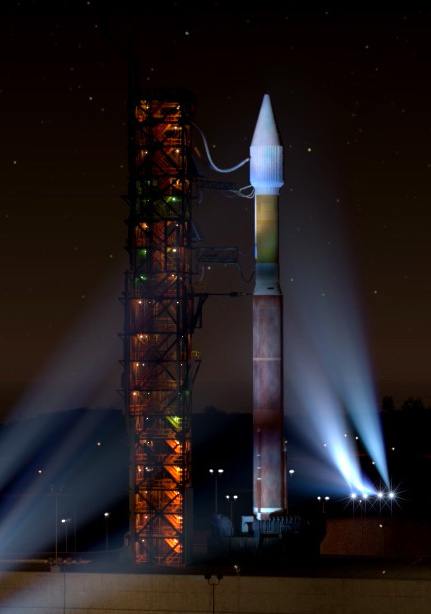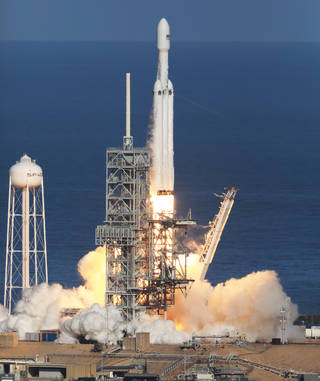Rocket Science (Literally)
Oct 22, 2020
By David Dezell Turner, Lucy Intern
The Soviet Union launched humankind’s first artificial satellite, Sputnik 1, on October 4, 1957, and the entire world looked heavenward in bewilderment. To put their beeping metal ball in orbit around the Earth, the scientists used a modified two-stage intercontinental ballistic missile, which they also named Sputnik. For months, the Sputnik rocket was the only successful satellite launch vehicle in operation. Then, on January 31, 1958, the United States launched their own artificial satellite, Explorer 1, aboard the four-stage Juno I. For the first time in history, there were two rockets carrying objects to space.

Needless to say, times have changed. The Cold War that ignited the Space Race is no more, but the fires of progress continue to burn. To meet the varied requirements of a multitude of space missions over the past six decades — from putting GPS and communications satellites in orbit to sending probes to Pluto and beyond — there now exists a diverse array of rockets built by a plethora of companies from a variety of countries, and each rocket is designed for a specific purpose.
The Lucy spacecraft will be flying aboard an Atlas V, a rocket manufactured by United Launch Alliance (ULA). Named for the mythical Titan who carried the world on his back, the Atlas V’s modular design has made it the rocket of choice for a wide variety of missions, including New Horizons (a mission to Pluto and the Kuiper Belt), OSIRIS-REx (a mission to asteroid Bennu), and Perseverance (the 2020 Mars Rover). The Lucy Mission will use the Atlas V 401, the same model used for the InSight Mars Lander in 2018. The “4” in 401 refers to the rocket’s 4-meter-long (13 ft) nose cone, the “0” refers to the number of solid rocket boosters attached to the main booster, and the “1” refers to the single Centaur upper stage. The earliest iteration of the Centaur was the first rocket to be fueled by liquid hydrogen. It is named for the horse-human hybrid of Greek mythology, since its high thrust-to-weight ratio makes it the perfect “workhorse” for rocketry, and it also contains important guidance and control systems (analogous to the mythical centaur’s human mind). The main booster is a Russian RD-180 engine, which burns liquid oxygen and a refined form of kerosene to produce over 860,000 pounds (3,800,000 N) of thrust. Even with the shortest available nose cone, the Atlas V 401 is 188 feet (57.3 meters) tall — taller than the Leaning Tower of Pisa. Since most of Lucy’s asteroid targets are named after characters from Greek mythology, it is fitting that she will be carried into space by Atlas and a Centaur.

Just as modern rocketry is the culmination of decades of innovation, today’s rockets are only stepping stones to the future. Science fiction stories like Star Wars present universes in which space vehicles are reusable and Han Solo can fly the Millennium Falcon across the galaxy as many times as he pleases. Meanwhile, most rockets in our galaxy can only be used once, which is one reason spaceflight is so expensive. NASA moved one step closer to the dream of reusability in 1981 with the debut of the Space Shuttle, which could reuse all of its major parts except for the orange external tank. Ever since then, rocket scientists have been working to drive down the cost of spaceflight by introducing more and more reusability. SpaceX regularly reuses the first stage of its Falcon 9 orbital rockets (appropriately named for Han Solo’s ship of choice), and it even once reused a Falcon 9 nose cone. Psyche, which the Lucy team considers its “sister mission,” will be flying on a SpaceX Falcon Heavy, whose boosters are also reusable. The team behind the Vulcan Centaur, a successor to the Atlas V that is in development at ULA, has teased concepts for the eventual reuse of Vulcan’s first stage as well. Blue Origin plans to use New Shepard, a fully reusable suborbital launch vehicle that currently carries scientific payloads, for carrying tourists into space as well.
Each of these uniquely designed rockets helps make missions like Lucy a reality. In this way, rocket scientists are helping to expand our knowledge of the universe, one roaring engine at a time.
References
-
Blue Origin. (n.d.). New Shepard. Retrieved July 20, 2020, from New Shepard.
-
Clark, S. (2019, November 11). Successful launch continues deployment of SpaceX’s Starlink network. Retrieved July 20, 2020, from Spaceflight Now.
-
Dismukes, K. (2013, August 23). Space Shuttle Components. Retrieved July 20, 2020, from spaceflight.nasa.gov.
-
Howell, E. (2018, February 22). Facts About SpaceX’s Falcon Heavy Rocket. Retrieved July 20, 2020, from Space.com.
-
Lemos, R. (2018, September 14). Sputnik Stunned the World, and Its Rocket Scared the Pentagon. Retrieved July 20, 2020, from Wired.com.
-
Mathewson, S. (2020, March 02). NASA picks SpaceX Falcon Heavy to launch Psyche mission to metal asteroid in 2022. Retrieved July 20, 2020, from Space.com.
-
NASA. (n.d.). Atlas V-401 Rocket – NASA’s InSight Mars Lander. Retrieved July 20, 2020, from mars.nasa.gov.
-
NASA Content Administrator (Ed.). (2015, March 20). Centaur - A NASA Workhorse. Retrieved July 20, 2020, from NASA.gov.
-
United Launch Alliance. (2015, June 1). Vulcan…in 134 seconds [Video file]. Retrieved July 20, 2020, from YouTube.
-
United Launch Alliance. (2019). Vulcan Centaur. Retrieved July 20, 2020, from the United Launch Alliance.
-
Wells, H. T., Whiteley, S. H., & Karegeannes, C. E. (1976). Origins of NASA names. Washington, D.C.: Scientific and Technical Information Office, National Aeronautics and Space Administration.